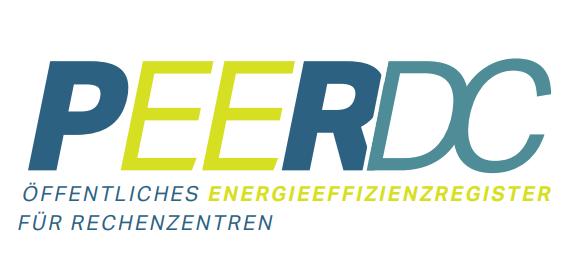
DC-Energy Efficiency Label Draft
Choose your key figures and observe the changes on the label.

Choose your key figures and observe the changes on the label.
Help us to make the DC label even more practice-orientated! We have prepared various questions and would be very pleased if you took the time to answer them:
This value is used to weight the individual LC values:

The Power Usage Effectiveness (PUE) is defined according to DIN EN 50600-4-2 as:

With:
EDC the total energy consumption of the data centre (annually) in kWh,
EIT the energy consumption of the IT equipment (annually) in kWh.
These typical PUE values are converted into an energy efficiency index (EEI) between 0 points (worst value) and 100 points (best value) using the formula described below:
PUE > 2.5 is set to 0 points, PUE < 1.1 is set to 100 points.
The Cooling Efficiency Ratio (CER) is defined according to DIN EN 50600-4-7 as:

With:
Qdissipated as the total (annual) amount of heat dissipated from the data centre in kWh,
Ecooling as the (annual) energy consumption of the cooling systems in kWh.
The value range of the CER is mapped linearly from [1;9] to [0;100] for the energy efficiency index:

CER ≤ 1 is set to 0 points, CER > 9 is set to 100 points.
The Energy Reuse Factor (ERF) is defined according to DIN EN 50600-4-6 as:

With:
EReuse as (annual) energy from the data centre in kWh that is used outside the data centre and completely or partially replaces energy there,
EDC as the (annual) total energy consumption of the data centre in kWh.
The CER is converted as follows for the energy efficiency index from 0 to 100 points:

ERF > 0.9 is set to 100 points.
The
load correlation (LC)
describes how well IT utilisation correlates with energy utilisation.
The already established key figure IT Equipment Utilisation of
Servers (ITEUSV)
is used as a value for the annual average CPU utilisation of all
servers.
It is defined:

With:
LCServer as dimensionless load correlation of the servers (0 to 100%),
ITEUSV as average (annual) CPU utilisation of the servers (0 to 100%),
EServer as (annual) energy consumption of all servers in kWh,
PServer_max as the sum of the maximum power consumption of all servers in full load mode in kW,
t as the measurement period in hours, for an annual value this corresponds to 8760h.
The useful work of the storage system usually consists of storage space allocation. It is therefore defined that the load correlation for storage systems (LCStorage) is the ratio between percentage storage utilisation and proportional energy consumption of the storage to its maximum energy consumption:

With:
LCStorage as dimensionless load correlation of the storage systems (0 to 100%),
Storage_Utilisation as average (annual) storage space utilisation (0 to 100%),
EStorage as (annual) energy consumption of all storage systems in kWh,
PStorage_max as the sum of the maximum power consumption of all fully occupied storage systems in kW,
t as the measurement period in hours, for an annual value this corresponds to 8760h.
For storage systems, it can be argued that their energy consumption does not correlate with storage space utilisation, but rather with data throughput during read and write activities. Therefore, if the storage space utilisation is taken as the unit of useful work, the energy consumption remains constant. To simplify, both energy consumptions EStorage and (PStorage_max * t) can be set equal, which leads to a denominator of 1 and allows the following simplification of the calculation rule:

The load correlation of network devices is defined as the ratio of the Network Utilisation (ratio of the number of connected ports with the number of available ports) and the quotient of measured energy consumption to the maximum energy consumption with full port occupancy:

With:
LCNetwork as dimensionless load correlation of the network (0 to 100%),
Network_Utilisation as the average (annual) utilisation of physical ports (0 to 100%),
ENetwork as (annual) energy consumption of all network devices in kWh,
PNetwork_max as the sum of the maximum power consumption of all network devices with fully occupied ports in kW,
t as the measurement period in hours, for an annual value this corresponds to 8760h.
And:

Ports here refers to the number of physical ports of all multiport bridge devices.